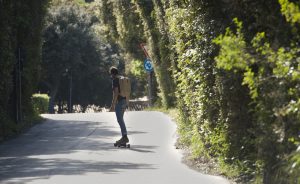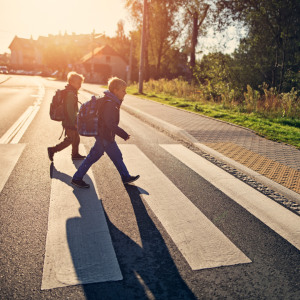“Among the new urban models being proposed to reconcile the new faces of mobility, the one theorized by Swiss urban planner Lydia Bonanomi is making a buzz. The idea behind that model is to reduce the speed of vehicular traffic to 30 km/h in urban centers.”
A transformation -much discussed- that would “reduce air noise pollution, decrease fuel consumption, increase safety on the roads, and recover land and quality of public sp ace.
ace.
The logic of a ‘City 30’ is opposed to the current car-centric model that involves, on average in Italy, the occupation of 80 percent of public space and that for 40 percent of cases involves trips of less than 4 km.”
The basic principle of the initiative revolves around the idea that urban livability and quality of life derive from public spaces. These, however, are referred to as plazas, parks, and streets, which means that the interaction between car and pedestrian traffic is a key factor.
Low-speed zones, consequently, are an excellent tool for managing this interaction, with numerous examples in the EU. Studies have shown that they reduce noise pollution, carbon dioxide, and nitrogen dioxide, and decrease the risk of fatal injuries.
Berlin adopted this policy in 2017. Initially, this caused traffic congestion, as well as spillover onto adjacent smaller roads and longer times for public transport. However, after some technical adjustments to traffic lights and an increase in the number of vehicles traveling the route, the situation has normalized.
Whoa! 😲
3⃣0⃣0⃣ citizens of #Milan lined up on this busy street to protect cyclists on a bike lane. They’re calling for 30km/h in the whole city and a stop to parking on cycle lanes.
Such a powerful action! 🔥💪🚲🚴#ProteggiMi pic.twitter.com/fsj9c1rLoV
— Clean Cities (@cities_clean) November 21, 2022
“Most people don’t know that 30 zones increase the quality of life and significantly reduce the risk of accidents, so an effective information campaign is needed to create a new traffic culture”
(Lydia Bonanomi, author of the book “Les Temps de Rue” and godmother of traffic moderation).
Benefits
Safety for residents, pedestrians, children, the elderly, bicyclists, and the disabled. Reducing speed means reducing risk exposure for drivers and those potentially coming into contact with the vehicle. A 10% reduction in speed results in a 30% reduction in fatalities. This occurs because at lower speeds the driver needs less space to cover in order to react and stop the vehicle. At 50 km/h a car needs about 28 meters to stop; at 30 km/h it needs only 13 meters. A reduction in speed in the city would greatly reduce the risk exposure of all vulnerable groups: children, the elderly, cyclists, and the disabled.
1. Noise reduction.
Noise pollution is an environmental problem caused by exposure to high levels of noise. This can have negative effects on human health and quality of life. The most frequent problems can be traced to pressure alterations, anxiety, stress, insomnia, nervous states, panic attacks in the most severe cases, and cardiovascular alterations. In urban areas, a reduction in speed from 50 to 30 km/h produces a 3db reduction in noise. A less noisy environment is also an environment where it is pleasant to walk and converse.
Japan was once ranked as the noisiest country in the world due to the high level of urbanisation.
Discover how the Japanese government is investing in R&D to reduce #NoisePollution and maintain its reputation as a peaceful and quiet place. #Japan 🇯🇵https://t.co/o7q6VucCPL
— Lios (@LiosGroup) February 28, 2023
2. Increased micro-mobility.
In “30 Cities,” there has been a boom in cyclists thanks to the spread of a new sense of safety: people cycle in a context where cars are forced to share space more equitably, says CleanCities’ Italian manager. Where the thirty-kilometer per hour limit is actually respected, there is also no need for excessive infrastructure. For example, a protected bicycle lane is not necessarily necessary: bikes, electric skateboards, or scooters would be indirectly “protected” from the low speed of motor vehicles.
3.Decreasing emissions.
In 2022, as many as 72 out of 95 cities in Italy exceeded the World Health Organization’s recommended limit on the amount of particulate matter PM10, particulate matter mainly produced by heating, which stands at an annual average of 20 micrograms per cubic meter of air. This is the finding of the report “Bad City Air 2023: Step Change Wanted,” compiled and published as part of the Clean Cities Campaign.
The cities that need to make the most effort are Turin and Milan (43% reduction needed), Cremona (42%), Andria (41%) and Alessandria (40%) for Pm10; Monza (60%), Milan, Cremona, Padua and Vicenza (57%), Bergamo, Piacenza, Alessandria and Turin (55%), for nitrogen dioxide (NO2).
Here you can find the most polluted cities in the world.
NO2 is a gas produced mainly by emissions from road traffic, particularly diesel vehicles, and at high concentrations, it can pose a health risk.
One of the factors that raise the most concern on this topic is the theory that if you travel at 30km/h you will consume more fuel. Let’s bust this myth.
Accelerate, brake, stop, restart. “Stop and go” causes more stress on the brakes and tires, and consequently more production of atmospheric particulate matter: “This is emitted not so much from the tailpipe but from the tires and brakes. A car’s acceleration consumption is much higher than its consumption at cruising speed. Studies often have unrealistic assumptions: they make assessments in ideal settings, where cars travel unimpeded and at constant cruising speeds. This is obviously not the reality of our cities,” argues Claudio Magliulo, the Italian head of Clean Cities Campaign.
It is true that “a car at a constant speed of thirty kilometers per hour pollutes about twenty-five to thirty percent more than a car traveling at seventy to eighty kilometers per hour.” However, “the thirty kilometers per hour limit creates a smooth flow of traffic and compensates for the engineering problem of increased emissions.” In addition, reducing speed also means that particulate matter remains at street level. The more cars speed, the more these substances rise into the air: “They get into buildings and fly up where the wind will move them even further away.”
4. More space available for pedestrians.
If the speed of cars is high, so are the braking distances, and so is the area occupied by road traffic, both in length and width. By reducing the speed in urban areas to 30 km/h, the space for cars can be slightly reduced, leaving more room for pedestrians and cyclists.
No “City 30” has shown an increase in travel time from point A to point B. According to a report by the Injury Prevention Bureau (IPU), with the lowering of the urban speed limit (from fifty to thirty kilometers per hour) travel times can drop by two seconds per hundred meters. And at peak hours this value can potentially drop to zero. Speed reduction, Upi points out, is unlikely to have a negative effect on city traffic, which depends on other factors such as the management and number of intersections, coordination of traffic lights, and the number of pedestrian crossings, and bus or streetcar stops.
According to architect Matteo Dondé:
“The intervention of experimenting with a Zone 30 or tactical urbanism involves identifying a residential neighborhood, possibly with the presence of a school, that has problems of crossing traffic, quality of public spaces and accidentality, and on this implement a complete traffic moderation project, carrying out all the phases foreseen and recommended by European manuals: neighborhood meetings for communication and awareness of the issue, project proposals, experimentation of low-cost solutions, verification of effects and consensus, progressive implementation of the planned interventions. In this way, the neighborhood can become the example for the entire citizenry to understand the benefits of traffic moderation and verify its effects, prior to the expansion of the Zone 30 project to other residential neighborhoods.”
Reducing the speed in urban centers will result in the development of new spaces for the inclusion of new pedestrian furniture and plants, so as to improve the quality of the street as a public space, thus transforming it into a space for relationships among a plurality of individuals (motorists, pedestrians, cyclists…) favoring socialization.
The street as an open, safe, and shared space to be returned to people. A space where the elderly feel safer, the child can walk to school, and the merchant happy because the street is livable if there are more stores, greenery, and benches.
Let’s see some good examples…
Helsinki
In Helsinki, the first wave of introducing large-scale 30 km/h restrictions took place in 2004, then the system was extended in 2019. First, it was used in the city center and some residential areas, then speed restrictions were modified in effectively all the streets. The adjustments were made in a way that they affect the traffic entering and leaving residential areas and the city center as well.
They do not monitor public opinion on this issue, but based on the reflections of the media it seems that citizens are satisfied. There is also a recent, 2022 poll concluding that 77 percent of Helsinki citizens feel safe in traffic, and only 5 percent answered that they find transportation in the Finnish capital dangerous.
Brussels
As of Jan. 1, 2021, Brussels introduced a citywide speed limit of 30 km/h. Results of the first 12 months:
- overall speed decreased by 9%,
- accidents by 22%,
- fatalities by 50 percent
- traffic noise by up to 50%,
- travel times by car remained the same or even slightly shorter.
Germany
In Berlin, where the speed limit applies to five main roads, significant improvements in air quality could be observed: especially the level of nitrogen dioxide decreased. In Hannover, they found that having a 30 km/h limit has no significant effect on the number of traffic accidents. On the other hand, they did find that in areas with such a limit the number of cyclists and pedestrians increase, and more people use public transport as well. This in turn has an effect on air quality and noise pollution.
Final Thoughts
“Climate change is a failure of imagination,” says Rob Hopkins.
The climate crisis requires us to deeply reimagine everything. It’s not just a matter of choosing to buy organic food or put a few solar panels on roofs. We need to rethink how various systems work.
We need to put all our attention into reimagining the system from the ground up.



